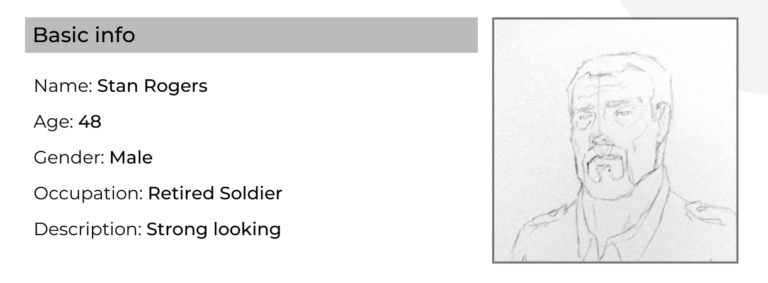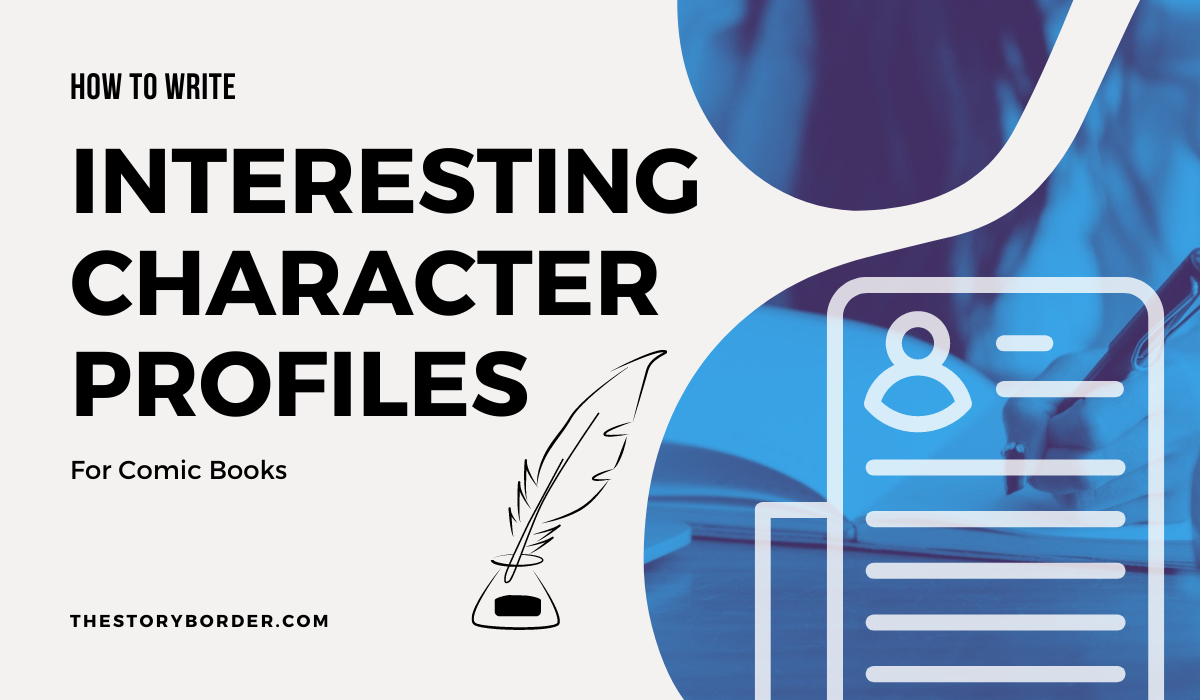How to write interesting character profile for comic books
💡 Disclaimer: I’m not a professional writer, I’m just an artist trying to write a short story so I can draw a comic about it. And these articles are just notes I make in my process of learning how to write.
Characters, one of the essential 5 elements of a story. They carry a plot, every event that happens in a story is connected to characters. Either character causes an event, or is impacted by an event. Good characters make us care about a story.
You can see why writing good characters is important, but why should you care? Why should a storyboard artist, concept artist, or an illustrator care about writing characters? Firstly, because it’s fun. Secondly, because it can help you create a portfolio. If you can write interesting characters and short stories, you can make a storyboard, comic book or concept art about that story and include it in your portfolio.
Basic Description
When writing a character, the easiest way to start is with some basic info.
- Name
- Age
- Occupation
- Basic Description
Writing name, age, occupation and some basic stuff helps you get a feel for what the character is all about. Some writers come up with names at the end of the writing process, and in the meantime they use number codes to differentiate characters. I personally like to start with a name. I don’t know about you, but for me, name Josh and Nathaniel have a completely different feeling. Starting with a name, gives me a overall feeling about the character, and then I can move on to fleshing it out.
💡 Just a heads up, at the end of the article I’m gonna leave you a template that you can use for writing quick character profiles 😉

Internal qualities
Now we’re gonna move to writing internal qualities. For this, I’m going to use a simple formula from this amazing video by Runesmith. All we need to figure out is these 4 things:
- Weakness
- Need
- Desire
- Enemy
I really like this approach, because figuring out characters’ Weakness, Need, Desire and Enemy allows you to come up with interesting characters in no time!
Secondary qualities
If you’re writing an unimportant side character, that’s it. You’ve done it. But let’s add a few more qualities to make it more interesting.
To make character more complex, you can always add secondary weakness, need, desire or an enemy. But here’s a list of few more qualities that you can consider (these are also from the video linked above).
- Rumors about the character
- Secrets
- Passions
- Accomplishments
- Are they happy? Why? Why not?
- Redeeming quality (in case you’re writing a bad guy)
Myers Briggs
One tool you can use when writing character profiles is the Myers Briggs personality test which consists of 4 categories:
- Introversion vs Extroversion
- Sensing vs Intuition
- Thinking vs Feeling
- Judging vs Perceiving
If you’re not sure what these mean, just ask yourself these questions:
- Where do you get energy? When alone (Introversion) or when around other people (Extroversion).
- How do you observe the world? Do you look for hard facts (Sensing) or do you get intuitive feeling (Intuition).
- How do you make decisions? Using logical thought (Thinking) or using gut feeling (Feeling).
- How do you organize your world? Do you plan everything to detail (Judging) or do you leave room for change (Perceiving).
I know that MBTI isn’t that useful as a real personality test, but it’s a quite a nice tool for writing. It allows you to come up with characters quickly, and when you get stuck in your story, knowing your character’s MBTI type can help you decide what next action would that character take.

Writing character backstory
When writing a backstory of a character, all we need to think about is how did they arrive at where they are now. So think of sets of events that brought the character to the current point of the story. If you’re writing a comic book superhero, think of what events made them become a hero. And what events made them become super (how did they get their superpowers).
But if you’re really stuck, and don’t have any ideas, you can answer these questions about your character to help you get started.
- Where did the character grow up?
- How does he/she feel about the place he/she grow up?
- How was he/she educated?
- What was his/her first job?
- Why is he/she doing his/her current job?
Just keep in mind that stuff like where was he educated, doesn’t necessarily mean formal education. If you’re writing a medieval knight, his education might mean where did he learn to fight, who was his mentor, and so on.
Also, if you’re writing a superhero, the question “Why is he doing his current job?” can mean why is he doing his literal office job, but you should also answer why is he doing his superhero job. For example, Peter Parker works as a photographer at Daily Bugle, because he needs to make money to pay rent. But he’s fighting crime as Spider-Man because of his uncle Ben’s death, and the iconic quote “With great power comes great responsibility”.
Example
Now let’s see an example of using this process. I’ll be writing a mentor character for my superhero that I might write a comic book about in the future.
Basic Info
So let’s start with the basics. For the name, I’ll go with Stan Rogers. He’s gonna be a retired soldier in his late 40s. He’s strong looking for his age.

Internal Qualities
Now let’s figure out his weakness, need, desire and enemy. I am writing a mentor character for my protagonist, but I don’t want him to be a perfect wise man. I think it would be interesting if his weakness is that he’s a bad teacher. Although he is smart and skilled, and wants to help our protagonist, he’s just not great at transferring knowledge. Maybe he’s trying to help her too much, giving her too much information and not letting her figure some stuff for herself.
For his need (notice, it’s different from desire, desire is something character actually wants, and need is something he has to do to improve or move the story forward), we’re going to derive it from his weakness. So he needs to have more trust in his mentee, and to figure out how to be a better mentor.
For his desire, I’m thinking that it would be interesting if he wants to find love, a woman that understands him, and someone he’s going to feel connected with.
For the enemy, he doesn’t really need to have one. He’s retired, he’s living a simple life, but maybe we can add something simple just for fun, like another man that’s interested in the same woman as he is. Note that in the story, we don’t necessarily need to write about his enemy, it’s just something to get us a better feeling for the character and his life.
Secondary qualities
Now let’s add a few more things. Maybe he has a secret, something from the military, maybe he did something he’s ashamed of, or something illegal and that haunts him. And let’s add passion, he likes to play chess.
And let’s finish it with MBTI type – ESTJ. Now, I don’t think this is important, but it might be useful in the future.
Backstory
For backstory we want to think, why is he mentoring our protagonist. Let’s say he did something bad when he was younger and feels guilty. So now he wants to help people and fight crime, but he’s too old for that, so he’s helping our protagonist.
And that’s it. Now, I understand that this is not a deep and complex character, but it’s something, we got started. In the future we can use this character profile when writing a story, to help us think of what that character would do.
Characterization
This is the most important thing about writing characters. It is how your character behaves throughout the story, what decision is he or she making, both small and big ones. This is how you make your character feel alive, but this topic requires an article of it’s own, and we’re gonna explore it in the future.
Conclusion
This is a really simple and quick method for generating interesting characters that I stumbled when learning how to write. I know it’s not perfect, but it’s something to get us started. We can always change it and improve in the future.

Nice post!